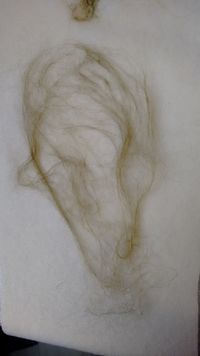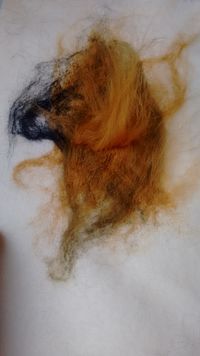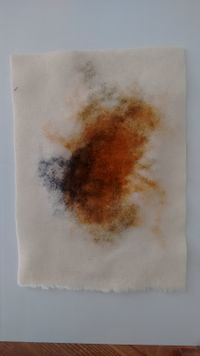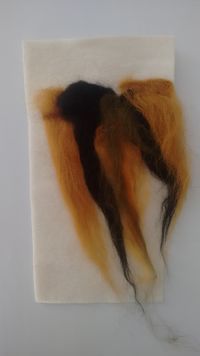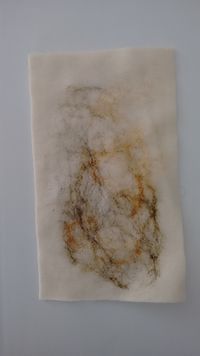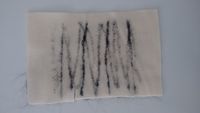Difference between revisions of "User:Robin cuppens"
Robincuppens (talk | contribs) |
Robincuppens (talk | contribs) |
||
| Line 44: | Line 44: | ||
Op de fabric station staat een punish machine. Deze machine en techniek heb ik nooit eerder gebruikt.<br> | Op de fabric station staat een punish machine. Deze machine en techniek heb ik nooit eerder gebruikt.<br> | ||
| + | Omdat ik hier erg benieuwd naar was wilde ik deze techniek gebruiken voor deze opdracht.<br> | ||
| + | [[File:mhand1.jpg |200]] <br> | ||
[[File:punishr1.jpg|200px]] [[File:punishr2.jpg|200px]] [[File:punishr3.jpg|200px]] [[File:punishr4.jpg|200px]] [[File:punishr5.jpg|200px]] [[File:punishr6.jpg|200px]] | [[File:punishr1.jpg|200px]] [[File:punishr2.jpg|200px]] [[File:punishr3.jpg|200px]] [[File:punishr4.jpg|200px]] [[File:punishr5.jpg|200px]] [[File:punishr6.jpg|200px]] | ||
Revision as of 11:43, 28 March 2017
Contents
Wrapping
Historical example
What is wrapping?
Wrapping is a technique to keep something together with a material. Without glue, only using a specific material to bind
Na een klein onderzoek gedaan te hebben over wrapping, kwam ik tot het besef dat wrapping veel voor de mens heeft betekend. Als je terug kijkt naar een van de eerste textiel en kleding van de mens is deze allemaal gemaakt doormiddel van wrapping. Vanuit deze gedachte wilde ik een stuk stof zelf weven. Maar ik wilde een stapje eerder inspringen in het ontwikkelingsproces van textiel. Ik ben vezels gaan twisten op verschillende manieren zodat er draad ontstaat. Dit leek mij de oorsprong van de wrapping techniek toegepast op textiel. Als eerste heb ik een stukje draad gemaakt door met mijn vingers te twisten, hierna heb ik het spinnenwiel gebruikt. Uiteindelijk heb ik ook nog gevlochten.
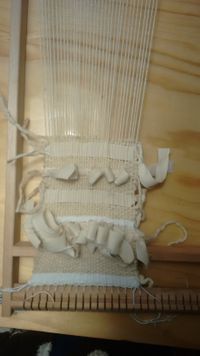 200px
200px
Geschiedenis
(Rope> Wikipedia) A rope is a group of yarns, plies, or strands that are twisted or braided together into a larger and stronger form. Ropes have tensile strength and so can be used for dragging and lifting, but are too flexible to provide compressive strength. As a result, they cannot be used for pushing or similar compressive applications. Rope is thicker and stronger than similarly constructed cord.
History of Rope (Wikipedia) Het gebruik van touwen voor de jacht, het trekken, het vastmaken, het bevestigen, het dragen, tillen, en klimmen dateert uit de prehistorie. Het is waarschijnlijk dat de eerste "touwen" van nature voorkomende zijn lengten van plantaardige vezels, zoals wijnstokken, snel gevolgd door de eerste pogingen tot draaien en vlechten.
Impressions of cordage found on fired clay provide evidence of string and rope-making technology in Europe dating back 28,000 years.[3] Fossilized fragments of "probably two-ply laid rope of about 7 mm diameter" were found in one of the caves at Lascaux, dating to approximately 15,000 BC.[4]
De oude Egyptenaren waren waarschijnlijk de eerste beschaving die speciaal gereedschap maakte om touw te ontwikkelen. Egyptische touw dateert uit 4000-3500 vC en was over het algemeen gemaakt van water riet vezels. [5] Andere touw in de oudheid werd gemaakt van de vezels van dadelpalmen, vlas, gras, papyrus, leder, of dierlijk haar. Door het gebuk van kabels konnen duizende werknemers zware stenen trekken voo et bouwen van monumenten. Vanaf ongeveer 2800 vC,wer er in china touw gemaakt va hennep vezelf. Hierna versprijd de ambacht van het touw maken zich uit tot Azie, India en Europa in de komende duizend jaar. touw gemaakt van hennep vezels in gebruik was in China. Touw en het ambacht van het maken van touw verspreid in heel Azië, India, en Europa in de komende duizend jaar.
In the Middle Ages (from the 13th to the 18th centuries), from the British Isles to Italy, ropes were constructed in ropewalks, very long buildings where strands the full length of the rope were spread out and then laid up or twisted together to form the rope. The cable length was thus set by the length of the available rope walk. This is related to the unit of length termed cable length. This allowed for long ropes of up to 300 yards long or longer to be made. These long ropes were necessary in shipping as short ropes would require splicing to make them long enough to use for sheets and halyards. The strongest form of splicing is the short splice, which doubles the cross-sectional area of the rope at the area of the splice, which would cause problems in running the line through pulleys. Any splices narrow enough to maintain smooth running would be less able to support the required weight.[citation needed]
In the Middle Ages (from the 13th to the 18th centuries), from the British Isles to Italy, ropes were constructed in ropewalks, very long buildings where strands the full length of the rope were spread out and then laid up or twisted together to form the rope. The cable length was thus set by the length of the available rope walk. This is related to the unit of length termed cable length. This allowed for long ropes of up to 300 yards long or longer to be made. These long ropes were necessary in shipping as short ropes would require splicing to make them long enough to use for sheets and halyards. The strongest form of splicing is the short splice, which doubles the cross-sectional area of the rope at the area of the splice, which would cause problems in running the line through pulleys. Any splices narrow enough to maintain smooth running would be less able to support the required weight.[citation needed]
Leonardo da Vinci drew sketches of a concept for a ropemaking machine, but it was never built. Nevertheless, remarkable feats of construction were accomplished without advanced technology: In 1586, Domenico Fontana erected the 327 ton obelisk on Rome's Saint Peter's Square with a concerted effort of 900 men, 75 horses, and countless pulleys and meters of rope. By the late 18th century several working machines had been built and patented.
Some rope is still made from natural fibres, such as coir and sisal, despite the dominance of synthetic fibres such as nylon and polypropylene, which have become increasingly popular since the 1950s.
Knot: A knot is a method of fastening or securing linear material such as rope by tying or interweaving. It may consist of a length of one or several segments of rope, string, webbing, twine, strap, or even chain interwoven such that the line can bind to itself or to some other object (the "load"). Knots have been the subject of interest for their ancient origins, their common uses, and the area of mathematics known as knot theory.
Knot theory is a branch of topology. It deals with the mathematical analysis of knots, their structure and properties, and with the relationships between different knots. In topology, a knot is a figure consisting of a single loop, abstracted from any physical rope or line, with any number of crossing or "knotted" elements. As such, it has no proper ends, and cannot be undone or untied. Various mathematical techniques are used to classify and distinguish knots. For instance, the Alexander polynomial can be used to distinguish the trefoil knot from the figure-eight knot and the unknot (a simple loop).[citation needed]
What kind of Wrapping do you have? ⁃ Knitting ⁃ weaving ⁃ knotting ⁃ binding ⁃ tufting ⁃ twisting ⁃ twirling
new skill-try out
Op de fabric station staat een punish machine. Deze machine en techniek heb ik nooit eerder gebruikt.
Omdat ik hier erg benieuwd naar was wilde ik deze techniek gebruiken voor deze opdracht.

